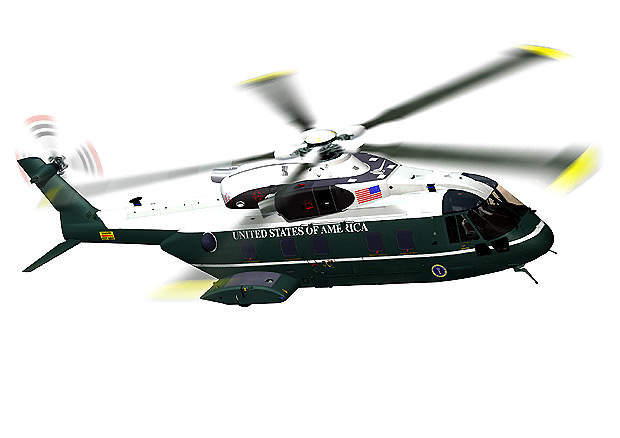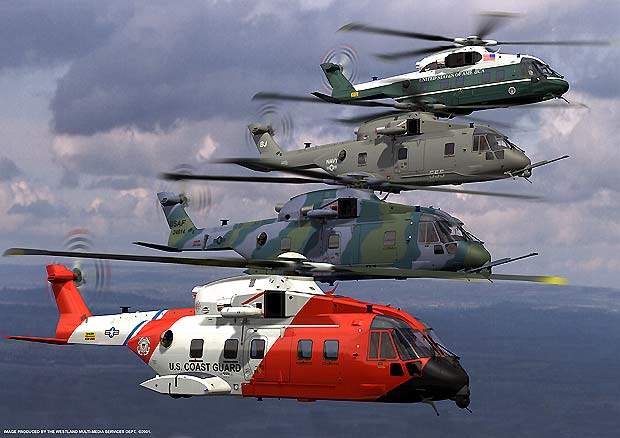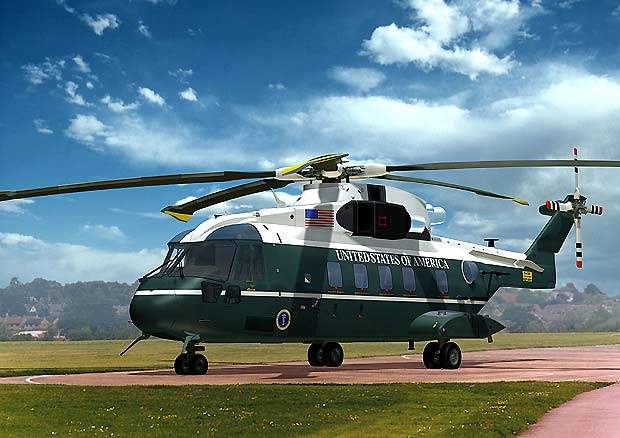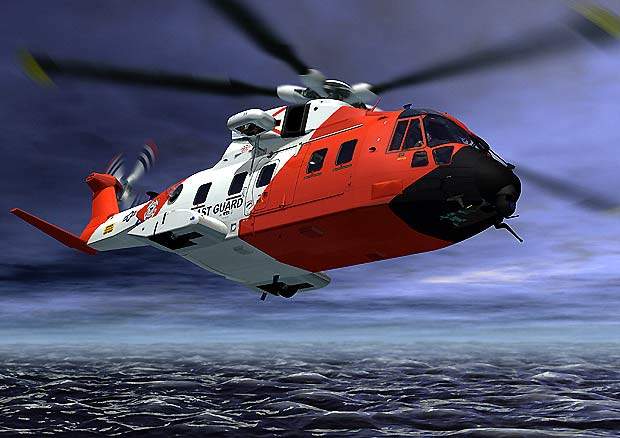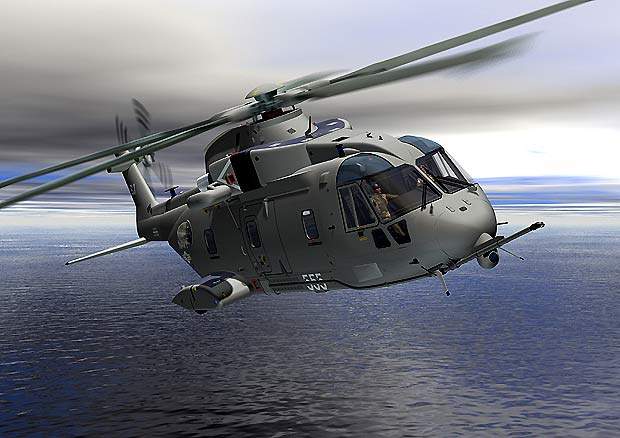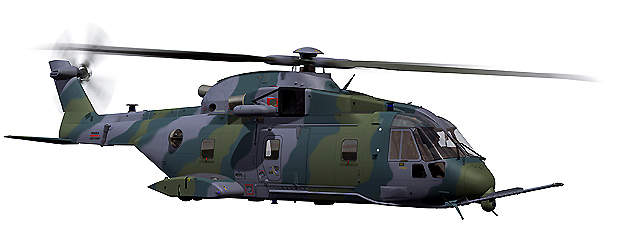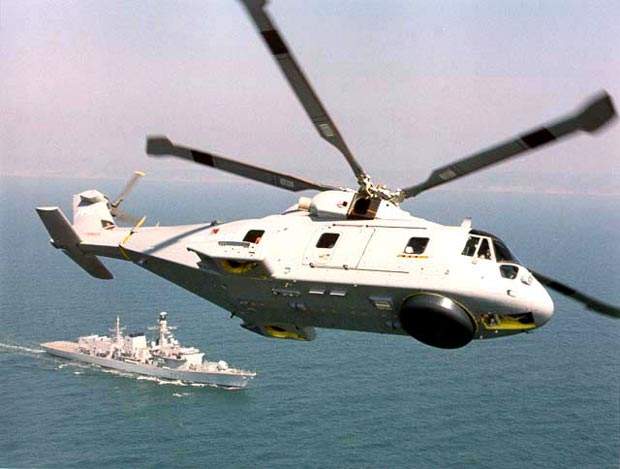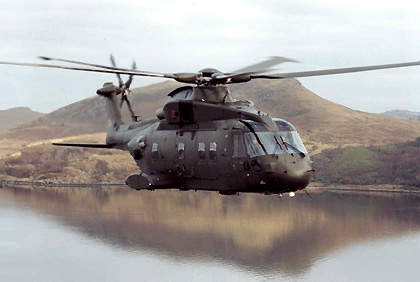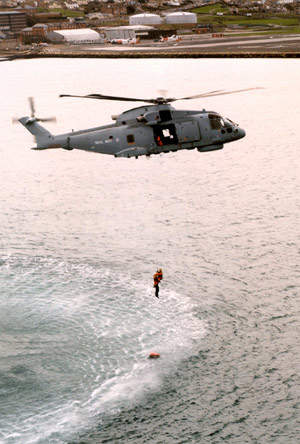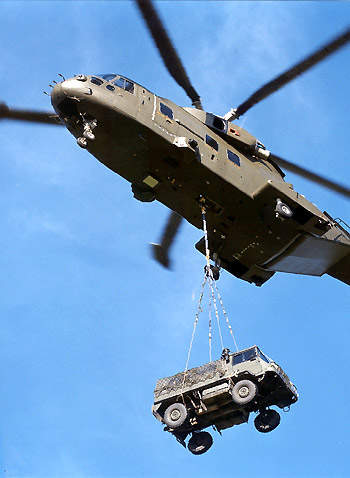The US101, or VH-71 Kestrel, is an all-weather, medium-lift helicopter that can be configured for a range of missions including combat search and rescue (CSAR), tactical troop transport (TTT), battlefield support, search and rescue (SAR), maritime surveillance, executive transport and airborne mine countermeasures (AMCM).
The US101 is the American version of the EH101 in service with the UK Royal Navy and Royal Air Force, the Italian Navy and the Canadian Forces and selected by Denmark, Portugal and Japan. The helicopter has been in service since 1998 and the fleet has accumulated 24,000 flying hours.
Team US101
Team US101 is an industrial collaboration between Lockheed Martin and AgustaWestland to market, manufacture and support the US101 helicopter in the USA. Under the agreement Lockheed will be the prime contractor for US customers. AgustaWestland has formed a joint venture company with Bell Helicopter to manufacture the aircraft in the USA.
Systems Integration will take place at Lockheed Martin Systems Integration – Owego in New York State.
Lockheed Martin and AgustaWestland collaborated on the production of the UK Royal Navy Merlin HM mk1 variant of the EH 101, in which AgustaWestland is responsible for the air platform and Lockheed Martin is the prime systems integrator.
US101 proposed replacement for US Marine One
In February 2005, the helicopter was chosen as the replacement helicopter for the 11 VH-3D Sea King helicopters of US Marine One presidential transport fleet requirement. However, in 2009 concerns over costing led to the contract being terminated.
The aircraft was given the designation VH-71A in July 2005. The US101 has over the mandatory 60% US content compared to the US manufacturing share of over 30% for the EH 101 build.
VH-71 Kestrel development
The first prototype VH-71 made its maiden flight at AgustaWestland’s facility in Yeovil, UK in July 2007, marking the beginning of the flight test programme. Two more prototypes began flight tests in January and February 2008, to be shortly joined by a fourth. The first production helicopter completed a maiden flight in September 2008. A second production helicopter joined the flight test programme in December 2008.
A version of the US101, the HH-71, is being offered for the USAF combat search and rescue (CSAR-X) requirement for 141 new helicopters to replace the HH-60G Pave Hawk helicopters. A contract was awarded to the Boeing team’s HH-47 Chinook but, in October 2007, the USAF decided to re-open the contest and issued new request for proposals and a contract award was expected in 2008. In December 2008, the USAF again restarted the competition but did not specify a date for contract award.
The helicopter provides safe, quiet and comfortable flight characteristics with g limits to +3g, can transport up to 30 troops or loads up to 5,443kg (12,000lb), has a maximum speed of 309km/h and a ferry range of nearly 2,100km.
Medium-lift helicopter design
The fuselage is constructed in four sections of high-strength, low-weight aluminium alloy and composite honeycomb panels. Kevlar and Kevlar-composite sandwich materials are used for the engine air intakes, sections of the tail and tail fin, ribs and longerons. High-strength composites are used for the windscreen, the upper cowling, and parts of the tail fin and tail plane.
The five-bladed main rotor is equipped with a multiple load-path hub and elastomeric bearings and full rotor ice protection. An active vibration cancelling system (ACSR) gives quiet and stable flight and allows optimum performance of search, surveillance and targeting systems.
Cockpit
The glass cockpit is night vision goggle compatible and has dual controls for single or two-pilot operation with dual redundant digital automatic flight control systems. The helicopter is equipped with a dual military standard 1553 databus for integration of the avionics and mission systems.
The communications include secure encrypted V/UHF, HF and satellite voice and data links and an information friend or foe IFF transponder including Mode 4 signal pulse spacing.
The navigation suite includes a digital map, global positioning system, inertial reference unit, Doppler radar and attitude and heading reference system. The helicopter is equipped with a VHF omni-directional radio ranger, instrument landing system, automatic direction finder and tactical air navigation aid (TACAN) which provides bearing and distance data of the aircraft from a ground based interrogator transceiver. The helicopter also has a deployable emergency emitter location system
VH-71 helicopters will have five Smiths Aerospace 10in x 8in (25cm x 20cm) liquid crystal displays.
VH-71 weapons
Weapon systems include air-to-surface missiles, rockets and machine guns. A 12.7mm machine gun can be mounted in a chin turret and machine gun pintle mounts can be fitted in the doorway and in the rear ramp way.
The helicopter can be equipped with a range of sensors, weapons, electronic warfare and self protection systems according to the mission requirements. The defensive aids suite installed on the US101 includes laser and radar warning receivers and a Doppler radar missile approach warner, chaff and flare dispensers and infrared countermeasures.
For the VH-71A Marine One, the US101 will be fitted with Northrop Grumman DIRCM (directional infrared countermeasures) System and ITT AN/ALQ-211 SIRFC integrated radio frequency countermeasures suite.
Sensor systems include tactical surveillance and over-the-horizon targeting, search radar, weather radar and forward looking infrared.
Cabin
The air-conditioned main cabin can carry 24 fully combat-equipped troops or up to 30 troops.
The helicopter is fitted with passenger and cargo doors, large sliding doors (1.83m wide) on the starboard side and a rear loading ramp door for fast and easy boarding and exit. 30 troops can board in less than two minutes and exit (or deplaning) of 30 troops can be accomplished in 40 seconds.
The US101 is capable of lifting up to 6t and the cabin is equipped with a variable speed cargo winch and roller conveyor for freight pallets.
For search and rescue missions the rescue hoist and winch are installed on the starboard side and the helicopter operates under hover trim control.
For emergency medical evacuation the seats can be removed to accommodate litters (stretchers) and medical attendants. The helicopter can be fitted with an aeromedical interior and Telemedicine data link for the air ambulance role.
Turboshaft engines
The US101 helicopter is fitted with three turboshaft engines with take-off power rating in the range of 1,550kW. The VH-71A Marine One will be powered by the GE CT7-8E engine. Other engines that can be fitted include the Rolls-Royce Turbomeca RTM 322-01-8 that is installed on the UK Royal Navy Merlin and the General Electric T700-GE-T6A installed in the Italian naval EH101.
Three standard self-sealing fuel tanks provide a fuel capacity of 3,222l. Each engine has a separate fuel tank.
The fuel system is equipped with emergency cross feed and computer controlled fuel management.
For extended range operation two auxiliary tanks can be installed in the cabin and one in the cargo hold. The endurance of the helicopter is over seven hours and the 1,389km (750nm) range on five internal fuel tanks can be increased by the use of the additional auxiliary tank or by air refuelling.
The helicopter has exceptional one engine inoperable performance as well as efficient high-endurance cruise speed and twin-engine operation for controlled hover and station keeping. The transmission has a 30 to 60-minute run-dry capability.

